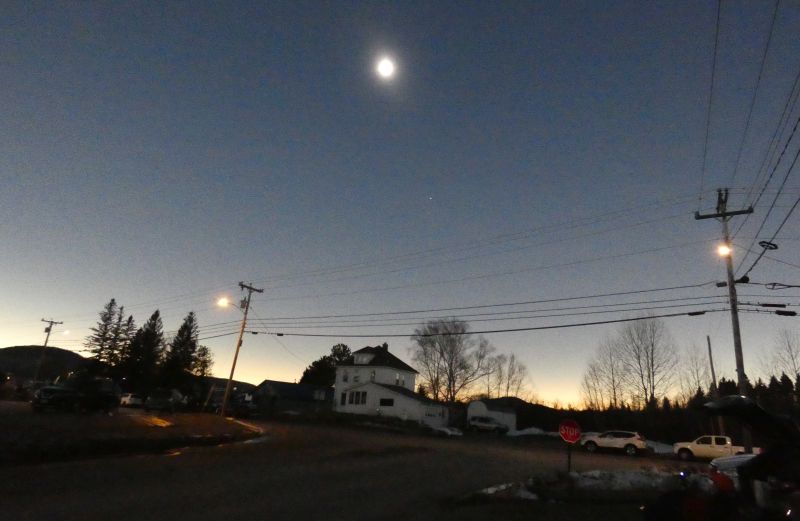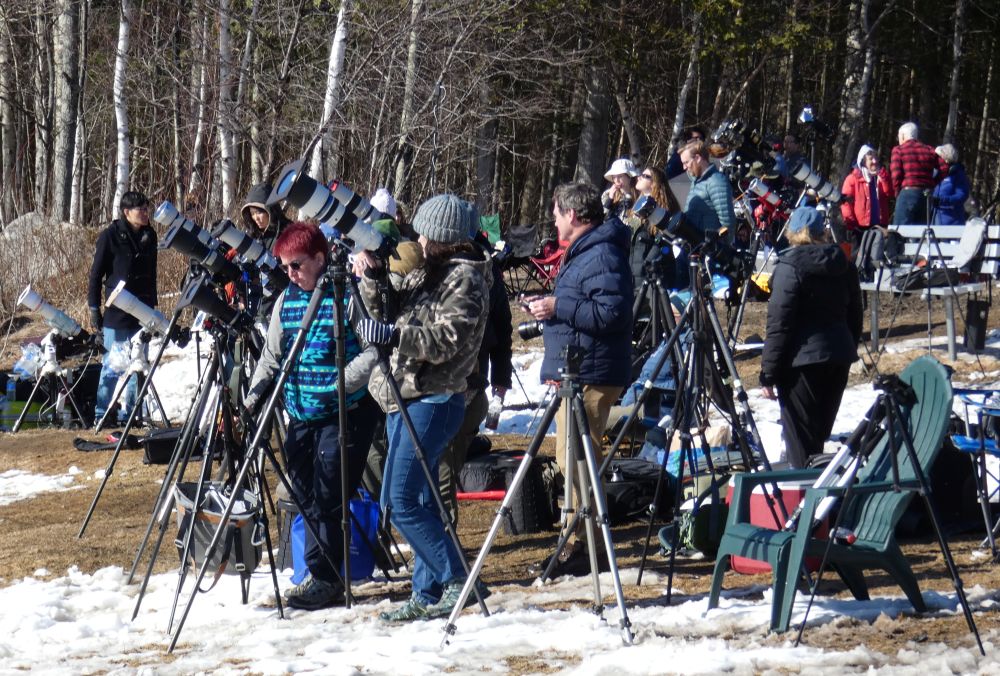
Chasing An Eclipse All the Way to Jackman

They came from near and far. They gasped in wonder and delight as day turned into night and back into day. “They” were the eclipse chasers. Most of them came from other parts of Maine, but a few came from as far away as Florida, Texas, Alaska, and California. They had all come to experience 3½ minutes of mid-afternoon darkness during the “Great American Eclipse of 2024.”
The April 8 event was the first total solar eclipse to pass through Maine since July 1963, and this time, Jackman was the place to be. As the Maine town closest to the center line of the eclipse — dead center was a few miles north in Moose River — the total phase, when the moon completely covered the sun, lasted 3 minutes, 28 seconds in Jackman, longer than in any other populated place in the Pine Tree State.
An estimated 10,000 people descended upon this hamlet of just under 800 souls. Ninety four miles from Belgrade, Jackman is the last town on Route 201 before the Canadian border. The influx of visitors offered an economic boost after a disappointing snowmobiling season — disappointing due to insufficient and unreliable snow.

According to news reports, some solar tourists booked hotel rooms in Jackman a year in advance, an act of either great faith or great folly, as clear skies were far from guaranteed. Indeed, for April 1‑15, Jackman has less than 20% cloud cover less than 10% of the time between 1:00 to 5:00 p.m. (That statistic comes from data compiled by the National Weather Service over nearly 4½ decades.) Or, put more simply, afternoons in Jackman are mostly cloudy most of the time during the first half of April.
But this year, we got lucky. Although the eclipse was total along a curved line through thirteen states from Texas to Maine, northern New England turned out to be the best place to watch. The region was blessed with clear weather, while much of the eclipse’s southern path, which is normally clear, had clouds.
Of course, not everyone went to Jackman — some stopped in Moscow, Bingham, or The Forks; others headed up I-95 to Houlton, Route 4 to Rangeley, or Route 27 to Stratton — but the eclipse likely brought more traffic to northern Maine than any other event since the last concert by Grateful Dead-inspired jam band Phish in August 2003, when, according to Rolling Stone, “more than 60,000 Phish fans witnessed the end of Phish’s summer tour” at the former Loring Air Force Base in Limestone.
While there are no comprehensive figures on the number of people who either came to Maine to view the eclipse or traveled within the state to see it better, the Maine Turnpike Authority estimated that around 30,000 motorists came through the York toll plaza the day before. That volume of traffic is typical for Labor Day Weekend but not for a Sunday in April.

On eclipse day, the drive from Belgrade to Jackman took 2¼ hours, due to the excess northbound traffic. Normally, it’s a little less than two hours. (Coming back after the eclipse took 5½ hours, as all the people who had been pouring into the region over the preceding few days ostensibly decided to leave all at once.) Starting in Solon, the southern edge of the zone of totality, cars were parked at rest stops, scenic turnouts, and any other place where people could safely pull off the road (and a few other places as well).
All along the way, enterprising homeowners posted signs inviting eclipse tourists to park in their dooryards for $20, $20, or even $40 for the day. Maine humor was also on display. At one house in Johnson Township, where parking was not being offered, there was a sign, saying “U Honk, We Moon.”
At the Attean Overlook at the height of land four miles south of Jackman, the northbound breakdown lane was lined with cars for at least a mile in either direction. This rest stop offers a stunning view of Attean Pond and Maine’s western mountains. Many visitors arrived a day or two earlier to claim a prime spot for viewing the 3½ minute spectacle.
It was a perfect day for an eclipse. Besides being sparklingly clear, the weather was unseasonably mild. All the way up to Jackman, my car thermometer registered temperatures in the mid-60s, although by the time I arrived, the air had cooled 56°.
The sun started to become noticeable dim 20 minutes before totality. Its light was like the harsh, white, filtered light of a November sun low in the sky a few hours before sunset. When viewed through eclipse glasses, which block a thousand times more light than ordinary sun glasses, the sun was but a slender orange crescent.
A few minutes before totality, shadow bands raced across the road in front of my parking spot. Resembling reflections of ripples on a still pond disturbed by a sudden breeze, shadow bands are wavy lines of alternating light and dark caused by the refraction in the earth’s atmosphere of the light from the slenderest of crescents just before and just after totality during a solar eclipse.
About 10 seconds before totality, a little ball of light briefly appeared on the edge of the solar disc. This phenomenon was first described in print after a 1912 total solar eclipse in Paris, when a reporter for French newspaper Le Figaro overheard a young woman exclaim (in French), “It looks just like an engagement ring!” The “diamond ring effect” is caused by the sun shining through a deep valley on the outer edge of the moon.

Then, at 3:29 p.m., the sun went black, with just a faint, circular glow from the solar corona visible around the edges of the moon. The total phase of a solar eclipse is the only time that it is safe to look at the sun without eye protection, as the sun is less luminous than a full moon.
Contrary to popular belief, the sky does not get completely dark during totality. It gets only as dark as it does half an hour after sunset, but during a total eclipse, the “sunset” is visible in all directions, instead of just in the west. During this twilight, the brighter stars and planets will appear. On that April afternoon, Venus was clearly visible below and to the right of the eclipsed sun.
All too soon, totality was over. The diamond ring briefly flashed again, the shadow bands rippled across the road, and the light returned. For the next hour, I peered at the sun intermittently through eclipse glasses as the moon’s bite gradually grew smaller. Then I began the slow drive home…
Back in Belgrade, where at maximum eclipse, the sun was 99% covered, the sun noticeably dimmed, but did not go black. Local observers could see the shadow bands and the diamond ring, with the latter lasting for a few minutes. (In Jackman and in other places where the eclipse was total, one could see the diamond ring twice, at both the beginning and the end of totality, but only for about ten seconds each time.)
If you missed the eclipse or would like to see another one, your next chance to see a total solar eclipse in Maine won’t come until May Day 2079. The total phase will last only half as long, just under 1¾ minutes in Maine, but the eclipse will be more convenient to view, as it will pass over the coast instead of our state’s sparsely populated and harder-to-get-to North Woods.
Belgrade Lakes Village will again lie outside the zone of totality, but those living in southern Belgrade may have a few seconds of darkness. For the full experience, though, future Belgraders will want to get into their hovercraft, gyrocopters, or whatever means of conveyance will be commonplace 55 years from now, and head south.
Download Full Newspaper: High Res | Low Res (Details…)
<— Previous Article • Summaries • Next Article —>
©2024 by Summertime in the Belgrades. All rights reserved.